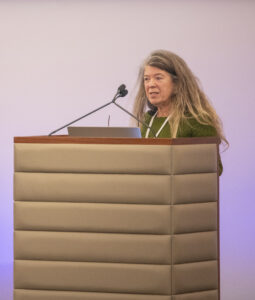We all have bodies and when we interact with robots we may become even more aware of our body. This awareness can mean we become more attuned to the physical contact we have with the robot, which can mean we notice the sensation of skin on metal or other hard material. The impact of the exchange of heat, pressure, vibration and so on can also prompt a greater sensorial awareness that can teach us more about our body’s capabilities and limitations. At root is the need for a trusting relationship that requires that interaction to be safe and avoid unintended harm. But how might that trust be extended or rethought when the interaction is between robots and skilled movers, in this case dancers? More particularly, what more do we learn when skilled dancers use a prosthesis or wheelchair? Dancers are not only expert movers but their expertise is informed by their knowledge of the body/machine interface so they already have a bodily awareness of what their body can do and what more (or less) it can do when joined with a mechanical device.
Moreover, dancers are naturally risk takers but what happens when their dancing “partner” is a robot? Is there a shared responsibility in moving together? What is the ‘language’ of the robots’ touch, the sensation of physical contact with a human body? How can robots be more responsive, sensitive, and alert to contact with ‘live’ bodies? And what might we learn about human-robot interaction that can be translatable to other contexts? In programming robots to always avoid collisions, how might the dancer influence thinking about the creative potential of ‘collision’?
The aim of our project is to answer these and other questions by exploring the idea of deeply embodied trust in autonomous systems through employing body-based methods, including contact improvisation and soma design, to examine the machine-body interface and reimagine bodily contact and collisions with robots as being creative and expressive, as well as trustworthy. Contact improvisation is a technique that dancers develop to work in relation with another dancer, involving weight supporting and weight bearing. The practice can range from very quiet and subtle contact through to more athletic exchanges of weight including rolling, lifting, weight catching, and also develops skills in how to resolve ‘accidents’ through mutual awareness.
Through a series of four workshops, we are employing a co-design methodology with dancers from a diverse range of experiences. Our approach ensures that the dancers are fully part of the research process, and where their perspectives and experience can direct the design of human-robot interaction, potentially transforming robots into behaving in more creative ways whilst incorporating new modes of synchronising movement to address safety and ergonomics. We plan to produce a range of outputs including a framework of concepts describing and relating different facets of the bodily experience of trust in autonomous systems; a portfolio of choreographic sketches as examples of dance interactions between humans and robots; and a novel methodological framework as well as publications and related workshops.
By involving professional dance artists and therefore skilled movers, the project will hopefully reveal to us more about the nature of touch, physical contact, sensorial awareness and embodiment more generally, as well as broader themes such as autonomy, responsibility and body-based trust, that can be transferable to help with thinking about rehabilitation technologies and assistive devices. The dancers’ lived experience of disability means they can explore a range of relationships with the robot/machine that may be one of friend or alien, or both, depending on the circumstances. In our first workshop, one dancer talked about robotic ‘armour’, which gives them protection and power. Another described how robots don’t ‘fit’ with their body.
Our TAS project develops from earlier work, involving many of the same team, that laid the foundations for this interdisciplinary project that combines expertise from dance, computer scientists and engineers. The earlier research involved disabled dancers performing improvised movement sequences that were captured and drove a computational design algorithm, which were then algorithmically mapped onto the shapes of prosthetic limb covers that could be 3D printed. The research generated questions about agency, appropriation and ownership, and challenged normative thinking in the context of digital technologies. Many of these issues, particularly that of how normative design models might be challenged through a process of embodied explorations, inform the methods we are developing here.
We propose that enabling richer physical interaction with robots has the long-term potential to address the TAS grand challenge of improving people’s physical and mental wellbeing. Opening up a wider range of trustworthy embodied interactions from delicate touching to lifting and supporting as we intend to explore through dance, can also inform new thinking about rehabilitation technologies and assistive devices.
Project team are Sarah Whatley and Kate Marsh from Coventry University’s Centre for Dance Research; Steve Benford, Feng Zhou, Praminda Caleb-Solly and Paul Tennent from University of Nottingham School of Computer Science; Rachael Garrett from KTH Royal Institute of Technology, Sweden; and artists associated with Candoco Dance Company
Skin Deep: Generative Co-Design for Aesthetic Prosthetics. In Proceedings of the 2023 CHI Conference on Human Factors in Computing Systems (pp. 1-19); Whatley, S., Benford, S., Marsh, K., Zhou, F., Ashcroft, I., Tennent, P., Welly O’Brien & Erhart, T. (2023). Personalising prosthetics: digital interventions in disability and dance. International Journal of Performance Arts and Digital Media, 1-16.
This TAS funded project is called: Embodied trust in TAS: robots, dance, different bodies.
